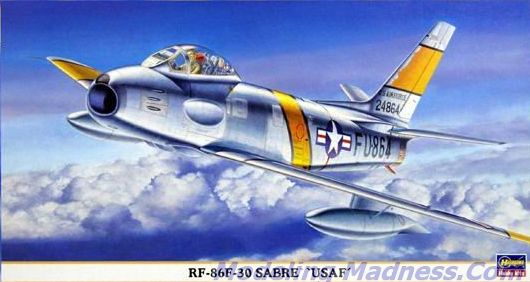
Hasegawa 1/48 RF-86F-30 'USAF'
| KIT #: | 09518 |
| PRICE: | 3800 yen when new |
| DECALS: | Three options |
| REVIEWER: | Scott Van Aken |
| NOTES: | Contains resin parts |

| HISTORY |
The F-86 entered service with the United States Air Force in 1949, joining the 1st Fighter Wing's 94th Fighter Squadron "Hat-in-the-Ring" and became the primary air-to-air jet fighter used in the Korean War. With the introduction of the Soviet MiG-15 into air combat in November, 1950, in which it out-performed all aircraft then assigned to the United Nations, three squadrons of F-86s were rushed to the Far East in December. The F-86 could out turn and out dive the Mig-15, but the MiG-15 was slightly superior to the F-86 in ceiling, acceleration, rate of climb, and zoom (until the introduction of the F-86F in 1953); and flown from bases in Manchuria by Soviet VVS pilots, was pitted against two squadrons of the 4th Fighter-Interceptor Wing forward-based at K-14, Kimpo, Korea. The first Mig-15 shot down by a Sabre was by a pilot of No. 335 Fighter Interception Squadron, Flight Lt John Nicholls RAF.
Superior US pilot training in comparison to that of North Koreans and the Chinese accounted for much of the F-86's success in achieving air superiority during nearly all of the hostilities. F-86 pilots also achieved a favorable kill ratio even over the Soviet piloted Mig-15s. Soviets piloted the majority of Mig-15s that fought in Korea, while inferior North Korean and Chinese pilots piloted the rest of the Mig-15s. The Soviets and their allies periodically contested air superiority in MiG Alley, a hotbed for air-to-air combat near the mouth of the Yalu River (the boundary between Korea and China). Some sources attributed the F-86E's all-moving tailplane to giving the Sabre a decisive advantage over the MiG-15. Far greater emphasis has been given to the training, aggressiveness and experience of the F-86 pilots. Despite rules-of-engagement to the contrary, F-86 units frequently initiated combat over MiG bases in the Manchurian "sanctuary".
Review of archived and previously classified documents released after the fall of the Soviet Union in 1991 disputes the numbers of claims by U.S. pilots, stating that the VVS lost only 345 MiGs. In turn the Soviets claimed to have shot down more than 1,300 U.N. aircraft including more than 650 Sabres. However, USAF records revealed that there were only about 660 Sabres deployed to the Korean theater in the entire war. This fact makes the Soviet claims highly dubious. USAF records also show 224 F-86s lost to all causes, including non-combat. Many air engagements are corroborated by both sides, but with conflicting claims of kills.
The needs of combat operations balanced against the need to maintain an adequate force structure in Western Europe led to the conversion of the 51st Fighter-Interceptor Wing from the F-80 to the F-86 in December, 1951. Two fighter-bomber wings, the 8th and 18th, converted to the F-86F in the spring of 1953. 2 Squadron SAAF also distinguished itself flying F-86s in Korea as part of the 18 FBW.
I also found it especially interesting that the F-86 had the same thrust to weight ratio as the P-59 Airacomet. Yet the F-86F was 300 mph faster and I know which I'd have rather taken into combat.
| THE KIT |
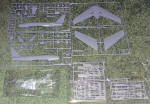 After
years of having little more than the Monogram and later ESCI kit, 1/48 Sabre fans were blessed
with two excellent kits in the Academy and Hasegawa F-86s. Both are worthy and
many have difficulty choosing between the two of them. My
most recent (if you can call 3 years recent) 1/48 F-86 was a Hasegawa kit
backdated to a slatted E and I was rather pleased with the result.
After
years of having little more than the Monogram and later ESCI kit, 1/48 Sabre fans were blessed
with two excellent kits in the Academy and Hasegawa F-86s. Both are worthy and
many have difficulty choosing between the two of them. My
most recent (if you can call 3 years recent) 1/48 F-86 was a Hasegawa kit
backdated to a slatted E and I was rather pleased with the result.
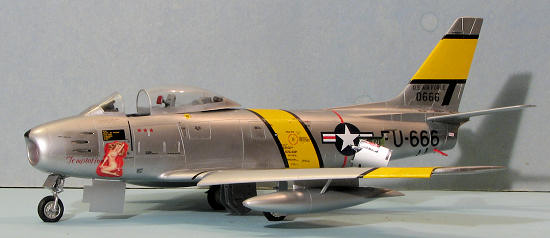 See
photo.
See
photo.
When Hasegawa first issued this kit, it was the extended wing F-86F-40 as used by the JASDF and it included markings for probably every Japanese unit that ever flew the plane. What most of us wanted was a shorter wing version as used in the Korean War and a bit later. Eventually, they came out with their 'US Air Force' boxing that had the shorter 6-3 wing (that is the one with the extended leading edges and no slats). This boxing is that kit, but with different decals and resin bits.
However, Hasegawa did not change anything else besides
the wings. With this in mind, there are some items in the
kit that are either not to be used or are not correct. For one, you won't use
the Sidewinders and their racks. These were not, as far as I can tell, ever
fitted to early USAF Sabres, though the Japanese and other users of the F-86F-40
version had this capability as did the very different F-86H. The![]() F-86F-30 was a fighter bombers so would have the option of inner pylons for
bombs and those are not included nor required for the recce version. The last biggie is that the fuselage is for an
F-86F-40. The biggest difference is the air scoop on the right fuselage behind
the wing. This should be filled in. I'm thinking there are other small vents
that are not appropriate as well.
F-86F-30 was a fighter bombers so would have the option of inner pylons for
bombs and those are not included nor required for the recce version. The last biggie is that the fuselage is for an
F-86F-40. The biggest difference is the air scoop on the right fuselage behind
the wing. This should be filled in. I'm thinking there are other small vents
that are not appropriate as well.
The molding is all that one expects from Hasegawa with crisply engraved panel lines. I did find that several parts suffered from mold faults in terms of sunken in areas. These are the gear doors and speed brakes, probably due to the thick detailing on the other side. The only part suffering from visible ejector pin marks is the seat bottom, where one is supposed to cover it with a pilot figure.
The cockpit is nicely detailed with raised instrument detail. A decal is provided for the main instrument panel and my experience with this fitting over the detail is quite positive. Side consoles will have to be painted as no decal is provided for them. Both intake and exhaust trunking is provided, along with a long seam on both sides that will be difficult to fill. Fortunately, Hasegawa also gives us intake and exhaust covers. I should also note that the speed brakes seem to have the proper droop, judging from the photos of the built kit on the instruction sheet.
Other things provided are both Korean War and post war drop tank fins, a separate canopy and windscreen so you can show off the interior, as well as engine intake compressor and exhaust compressor faces should you wish to not use the covers. There is also room for nose weight around the intake trunking.
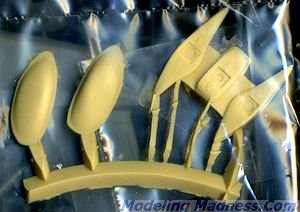 As mentioned, this is a reboxing with different decals
and the resin bits for the cameras.
An acetate sheet is provided for camera windows and a template is included in
the instructions. Instructions are peculiar to the RF variant and even show you
filling in the gun ports and cutting a section of the lower fuselage fo
As mentioned, this is a reboxing with different decals
and the resin bits for the cameras.
An acetate sheet is provided for camera windows and a template is included in
the instructions. Instructions are peculiar to the RF variant and even show you
filling in the gun ports and cutting a section of the lower fuselage fo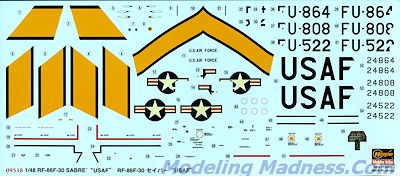 r
the camera windows. Decals are provided for three very similar aircraft, all
with the yellow wing and fuselage bands. Only the box art plane is identified by
unit, that being the 67th TRW from 1953. The third option does not have the fin
band. I'm not sure of aftermarket for this variant, but not all that many were
built. As the real plane had the gun ports painted on, Hasegawa does provide
those as decals on its nicely printed sheet.
r
the camera windows. Decals are provided for three very similar aircraft, all
with the yellow wing and fuselage bands. Only the box art plane is identified by
unit, that being the 67th TRW from 1953. The third option does not have the fin
band. I'm not sure of aftermarket for this variant, but not all that many were
built. As the real plane had the gun ports painted on, Hasegawa does provide
those as decals on its nicely printed sheet.
One note is that the 6-3 wing was first factory installed on F-86F-30 52-4505 and so the kit wings are correct for all three options.
| CONCLUSIONS |
If you are a Sabre fan and want to build a family of them, then this is a version you need to seek. This kit is dated 2003 so you'll have to do a bit of searching to locate one.
| REFERENCES |
http://en.wikipedia.org/wiki/RF-86F_Sabre
July 2014
Thanks to me for the preview kit.
If you would like your product reviewed fairly and fairly quickly, please contact the editor or see other details in the Note to Contributors.